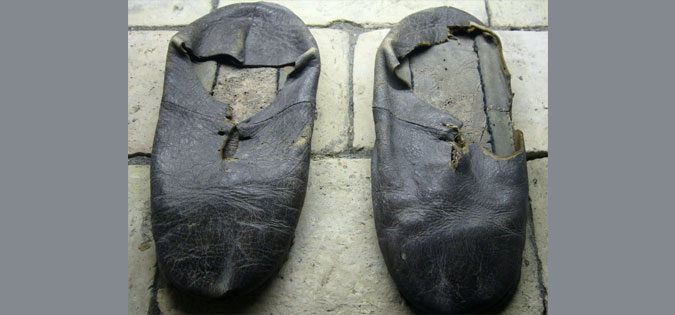 We have taken a rather brisk tour through the life of St. Ignatius during the past few weeks, following the pilgrimage that is his life story. Now let’s glean some general principles of pilgrimage that apply to each one of us.
We have taken a rather brisk tour through the life of St. Ignatius during the past few weeks, following the pilgrimage that is his life story. Now let’s glean some general principles of pilgrimage that apply to each one of us.
1. Pilgrimage presents itself, but we decide to go or stay.
Ignatius could have responded in other ways to his months of healing from the cannonball incident. He could have set his mind in a particular direction and ignored what his soul was discovering in those many hours of quiet. In fact, he could have refused to contemplate at all and filled his life with distraction rather than discernment.
Yet he chose to pay attention, to courageously reflect on his life and explore what God was saying to him. The pilgrimage truly began with Ignatius’s willingness to begin. God does not coerce us to go anywhere or do anything. God invites us—through circumstances, through our intuition, through our gifts and opportunities, even through our trials. And we make the decision to begin. Then we make the daily decision to continue.
2. The pilgrim path never goes in a straight line.
If the path were straight, it would not be a pilgrimage. Ignatius thought he would go to Jerusalem, but he was not to remain there. He thought he would be just a poor beggar, but God took him to a position of leadership. His education and eventual ordination led through multiple schools and situations. At one point the pope advised Ignatius and his companions to join an existing order, but they discerned that this was not God’s will for them. Ignatius dreamed of traveling the world, sharing the Good News; yet his primary ministry happened at a desk in Rome.
We obtain a degree in one field but end up working most of our career in a different one. We think God is calling us to the life of a vowed religious, but in seminary we fall in love and realize that marriage is our true vocation. We dream of one ministry but are guided, step by step, to another one. We plan to live in one region but find ourselves exploring new territory. Every turn in our life requires discernment and faith. Every path takes us through dark patches in which we cannot see the next event or relationship or life work. This is how it is supposed to be.
3. God uses our mistakes, our lack of knowledge, and our weaknesses all along the way.
When God began to speak to Ignatius, God knew the exact nature of this human raw material. God was dealing with a Spaniard, a soldier, a semi-nobleman with big dreams and an ego to match. God knew that Ignatius had lost both parents relatively early in his life, and that he was formed during an era of much drastic change in the world.
God knew every weakness, every sin, and every desire that resided in Ignatius. God knew every wound and setback and fear. God also knew every gift and talent and natural inclination, every form of intelligence and aptitude working in the life of this young man. And God used all of it—just as God will use all the raw material of my life and yours. God uses our sensitivities to create our strengths, our desires to create ministry.
4. We learn by walking.
We can look at Ignatius’s life and see a lot of stumbling and struggle. But what we do not see is passivity and inactivity. Ignatius got an idea and went after it—and if he had the wrong idea, then God simply redirected him through circumstances, prayer, and the counsel of others.
Pope Francis has said that he would rather see a Church that is out in the world, getting into accidents, than a Church that is passive, ingrown, and sick. We learn God’s will by moving toward something—whatever seems right to us. In the way that you cannot steer a parked car, God cannot direct us while we are sitting rigidly in our fear and over-caution and our need to know every detail before acting. Our desire for certainty will stop our forward movement as surely as our sin and error will stop it.
What have you learned about pilgrimage?

Here are a few questions to help us reflect on St. Ignatius’s pilgrimage and ours.
What aspects of Ignatius’s life resonate with you most, and why?
What principles of pilgrimage have you discovered already on your own life journey?
- Pilgrimage presents itself, but we decide to go or stay.
- The pilgrim path never goes in a straight line.
- God uses our mistakes, our lack of knowledge, and our weaknesses all along the way.
- We learn by walking.
Would you add any principles to this list?
What would you say to someone who is struggling to say yes to pilgrimage—to someone afraid to start or needing more certainty?
What would you say to a person who is experiencing confusion because her path is going a different direction than she expected?
Any of us who has used a GPS system to guide a physical journey has encountered the term “recalculating”: it means that we went off-course, and now the GPS is coming up with an alternate route to get us back on track. When your life has gone off-course and God is having to recalculate for you, what practices can help you remain calm, hopeful, and faith-filled?

Pilgrimages are good for one’s spiritual and physical well being. Walking pilgrimage is burning one’s own fat and not burning fossil fuel.
Your writings are so inspiring. Thank you for awakening in me the true meaning of a pilgrimage.
I was in Spain last spring, and visited the Sanctuario of Loyola, the Cova de Manresa, the Cardoner river, passed by Pamplona, and we renewed our wedding vows in Montserrat—-all of which occurred while I was doing my 19th annotation. It was quite an immersion into the life of St Ignatius. I know I am so blessed to have been able to do this.
This autumn retreat created very vivid visions of the places I visited earlier this year. Thank you!
I would add reoccurring situations to the principles of pilgrimage. I have found myself struggling to learn from certain experiences over again, when I haven’t got them right the first time.
My life has been a pilgrimage to the heart of God. Thank you so much for this teaching. I am 80 years old, have known myself to be a child of God since awakening to the fact as a
three year old. But the path has been so convoluted that I have often seen my faith life as a failure. I’ve had goals of being a missionary, a saint, a contemplative, a servant, even a spell as an atheist. But at every twist and turn I can clearly see that my GPS was set to “The Heart of God” and that path has lead me through the hearts of family members, church members, friends, to a kind of embracing of the hearts of all people and all of creation.
The GPS image and “recalculating” gave me a wonderful “aha!” moment and I want to thank you for the inspiration. Blessings